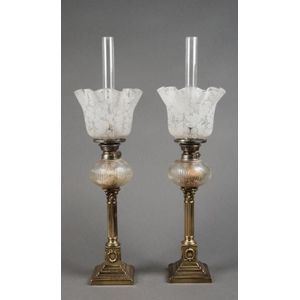Rococo-inspired French Marble and Glass Kerosene Lamp
You must be a subscriber, and be logged in to view price and dealer details.
Subscribe Now to view actual auction price for this item
When you subscribe, you have the option of setting the currency in which to display prices to $Au, $US, $NZ or Stg.
- Circa - A Latin term meaning 'about', often used in the antique trade to give an approximate date for the piece, usually considered to be five years on either side of the circa year. Thus, circa 1900 means the piece was made about 1900, probably between 1895 and 1905. The expression is sometimes abbreviated to c.1900.
- Belle Epoque - The Belle Époque, also known as the "Beautiful Era," was a period in European history that lasted from the late 19th century to the outbreak of World War I in 1914. The term is most commonly associated with France, but is also used to refer to the same period in other countries, particularly in Western Europe and Latin America.
During the Belle Époque, Europe experienced a time of great prosperity and cultural, artistic, and scientific advancements. It was an era of peace and optimism, characterized by industrial growth, urbanization, and new technologies such as electricity, automobiles, and the telephone. The period is also associated with a flourishing of art and culture, particularly in the fields of literature, music, and the visual arts. - Ormolu - Ormolu was popular with French craftsmen in the 18th and 19th century for ornamental fittings for furniture, clocks and other decorative items. True ormolu is gilt bronze, that is bronze that has been coated with gold using a mercury amalgam. Due to the health risks associated with using mercury, this method of creating ormolu was discontinued in France in the 1830s. A substitute was developed consisting of about 75% copper and 25% zinc, however it was inferior to the bronze version. It was often lacquered to prevent it tarnishing.
This item has been included into following indexes:
Visually similar items

A late Victorian brass and green glass oil lamp, apparently unmarked, the burner and chimney within a green-tinted domed shade etched with foliate decoration above the moulded opaque pale green fount, on a Corinthian column and moulded stepped square base.

Pair of antique oil lamps; single burners with cut crystal fonts on brass Corinthian column bases, acid etched shades and glass chimneys. 54 cm each

An antique banquet lamp. Late 19th to early 20th century, maker's mark of John Scott, England, with a shaped chimney, kerosene font in pressed peach coloured glass and operational burner assemblies above a brass Corinthian column to a squared spreading bas

French oil lamp, with amber reservoir, 53 cm high
